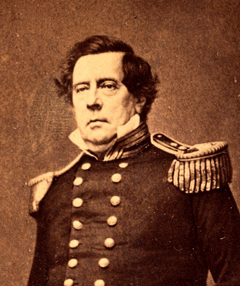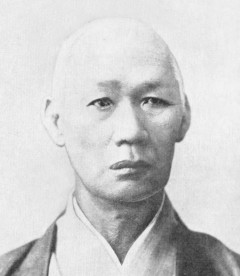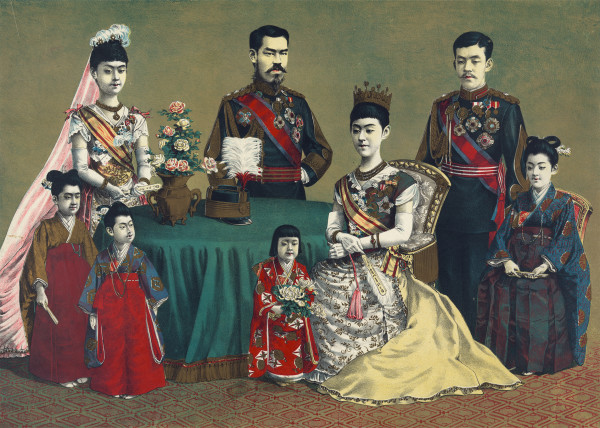The Floating Kingdom
Edo Period
No foreigners were allowed on Japanese soil during a period of international isolation in Japan from 1603 to 1867. During this period the emperor was largely a figurehead and the country was run by a military dictator called the Shogun. However, this was also a period of rapid economic development and prosperity, stability and culture. There were four classes of social order and movement between them was prohibited: warrior, merchant, artisan and farmer. The warrior class consisted of samurai, who, not having any wars to fight, became bureaucrats over their own domains. Large urban areas were created, including Edo (present day Tokyo) and Kyoto. At the time of Perry’s arrival, Tokyo was the largest city in the world with one million inhabitants. Trade between the urban centers gave rise to a wealthy merchant class who in turn financed a flourishing of the arts. 80% of the population were farmers whose work provided income for the higher classes.
“So long as the Sun shall warm the earth, let no Christian dare to come to Japan; and, let all know that the King of Spain himself, or the Christian’s God,…if he violates this command shall pay for it with his head.” – Shogun’s Edict of 1638
Commodore Matthew C. Perry

photo of Matthew Perry by Mathew Brady
Born in 1794 to a miliary family, and after a long career, Commodore Perry was tasked by President Millard Fillmore to force open Japan’s ports to trade. He determined the most successful way would be a fierce display of strength rather than traditional diplomacy. Therefore, carrying a letter from the United States president, Perry sailed steam engine ships into the Uraga harbor with guns drawn and threatened destruction if he was turned away. Perry delivered the letter and returned six months later to sign the Treaty of Kanagawa. He died two years later from cirrhosis due to alcoholism.
“Perry cares no more for right, for consistency, for his country, than will advance his own aggrandizement and fame, and makes his ambition the test of all his conduct towards the Japanese.” - From A Journal of the Perry Expedition to Japan, 1910, by S. Wells Williams, First Interpreter of the Expedition
Convention of Kanagawa

The Mission of Commodore Perry to Japan in 1854 by Hibata Osuke
The Japanese recognized that they were unable to mount a defense to the technology of the American steam engine warships. Therefore, on March 31, 1854, they acquiesced to American demands and met in Kanagawa where they signed the Treaty. The Treaty of Kanagawa gave Americans their requests of better treatment of castaways, opened up two Japanese ports, and allowed for an American consul. The result of the convention was an immediate end to Japan’s isolation and after the treaty was signed, other western governments poured into Japan seeking their own negotiations.
“This is really like opening the door and receiving robbers!” – From the diary of Koga Kinichiro Masaru, Confucian scholar, January 1854
John Manjiro

photo of John Manjiro circa 1880
Also known as Nakahama Manjiro. When John was only 14 years old, his fishing boat was shipwrecked off the coast of Japan. After six months, he was rescued by an American whaling ship who brought him to the United States, where we remained for a decade. During that time, he received an American education, joined a whaling ship himself, and participated in the California Gold Rush. Although it was against Japanese law to leave the island and later return, he decided to come home. Upon his return in 1851 he was interrogated by samurai officials but released after he told them all about the Americans. When Commodore Perry arrived in Japan, Manjiro was made a translator for the Convention of Kanagawa. Later in life, he served at the Japanese embassy in the United States and on the faculty of Japan’s Kaisei College.
Emperor Meiji

The Japanese Imperial Family with Emperor Meiji by Torajiro Kasai in 1900
Born in 1852, and given the title Prince Sachi, Emperor Meiji was only one year old when America entered the Japanese harbor. After he was crowned in 1867 and given the title of Emperor, Meiji’s reign transformed Japan into a great industrialized power. He was a strong believer in modernization and launched Japan on the course of westernization. His coronation also signaled the end of the Edo period and shogunate and a return to imperial rule. He died in 1912 leaving behind a Japan unrecognizable from the one of his birth.